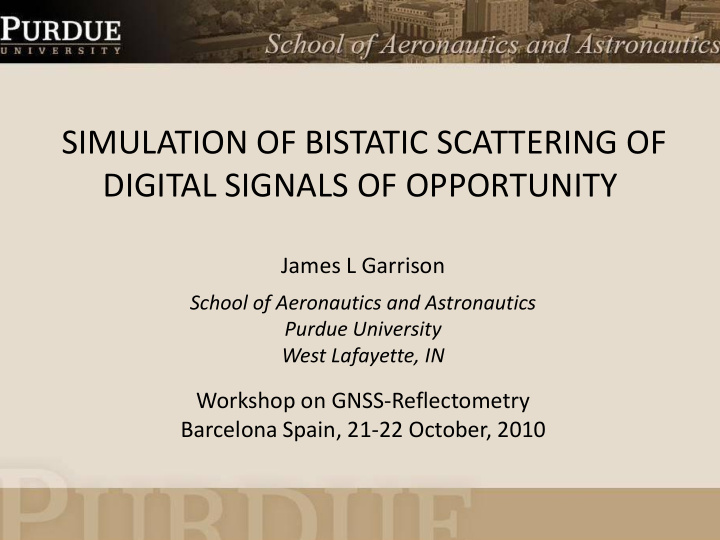



SIMULATION OF BISTATIC SCATTERING OF DIGITAL SIGNALS OF OPPORTUNITY James L Garrison School of Aeronautics and Astronautics Purdue University West Lafayette, IN Workshop on GNSS-Reflectometry Barcelona Spain, 21-22 October, 2010
Outline • Background • Theory and Model • Simulator architecture • Example results • Conclusion
Background • Extensive reflected GPS data available from airborne experiments (1997 to present) – Empirical evaluation of accuracy for sea roughness, soil moisture, alimetry – Almost exclusively GPS C/A (BPSK(1))
Background • Mission plans/proposals for satellite experiments – Specification of antenna gain, integration time, etc – Realistic simulation of measurement statistics necessary • Galileo would ~double number of reflections – More complex BOC modulation • Other signals of opportunity (non-GNSS) – Diversity of modulations (QPSK, etc) and frequencies
Background • Simulated delay-Doppler map (DDM) generator developed during sabbatical at Starlab, Barcelona (2007-08 AY) • Theory from You’s PhD thesis [You, et al, 2004] • Simulator developed during sabbatical at Starlab, Barcelona (2007-08 academic year)
Stochastic Signal Model ˜ • DDM’s are correlated in time ( ) and between bins t • Statistics must be adequately represented in simulation (ie, separation of independent samples) • You etal, (2004) model for autocorrelation I ( r f ( r ) j d 2 r R Y ( ˜ ˜ E Y ( t , , f ) Y * ( t , , f ) e 2 t , , f ) t , , f )
Stochastic Signal Model Receiver Waveform Position generated at time t 1 at time 2 1
Stochastic Signal Model • Spectrum derived earlier by Zuffada and Zavorotny (2001) W Y ( ˜ 2 ( , ˜ t , , f ) e 2 ˜ ˜ R Y ( ˜ j d ˜ f t 2 ( )* f , , f ) t f , f ) • Bin-Bin correlations take the form
Simulator W.G.N. W.G.N. W.G.N. N 0 N 0 N 0 … CT I CT I CT I S ( f , 1 ) W.G.N. S ( f , 2 ) W.G.N. … … … S ( f , n ) W.G.N.
Simulator vs. Actual data Synthetic Waveform Hi-Winds Experiment
BOC Modulation 2 Y ( ) 2 Y ( ) BPSK(1) BOC(1,1)
Bin-Bin Correlation BPSK(1) Model 10 km Altitude
Monte-Carlo Simulation 10 km altitude Green = Simulation 45 dB-Hz C/N0 Blue = Sampled at 1/4 chip 0.63 Reflectivity Black = “Good” Fit Red= “Poor” Fit
Simulation Results BPSK(1) BOC(1,1) [Presented at IGARSS 2009]
Digital Satellite Signals of Opportunity (DSSO) • First airborne experiment: Summer 2010 ~3100m • XM Radio: 2342.205 MHz, QPSK. 8MHz/8bit sampling • Model link budget matches experiment (direct signal) within 0.2 dB - forT I =1 to 35 ms
Bistatic Radar with XM • Zavorotny-Voronovich Model: • 7.5 m/s Wind speed • Elfouhaily spectrum • No “fitting” of PDF! • 10 ms coherent integration [Presented at IGARSS 2009]
Conclusions • Numerical simulator for GNSS-R waveforms developed • Temporal correlation shaped by model • Bin to bin correlation not yet implemented • “Poor” fits to BOC waveforms were common – More frequent at low roughness values – Easily detection by residual test – “Good” fits had acceptable statistics
Acknowledgements I wish to thank Starlab, Barcelona for supporting this research during my 2007-08 sabbatical. XM Radio DSSO data were collected by my graduate student Rashmi Shah, who was supported by NASA Langley Research Center.
References You, et al, “Stochastic Voltage Model and Experimental Measurement of Ocean- Scattered GPS Signal Statistics,” IEEE TGARS, V42, N10, Oct. 2004, pp 2160-2169. C. Zuffada and V. U. Zavorotny , “Coherence time and statistical properties of the GPS signal scattered off the ocean surface and their impact on the accuracy of remote sensing of sea surface topography and winds,” in Proc. IGARSS, 2001, pp. 3332 – 3334. Betz, “Binary Offset Carrier Modulations for Radionavigation ,” Navigation, V48, N4,Winter 2001 – 2002, pp 227-246
Recommend
More recommend